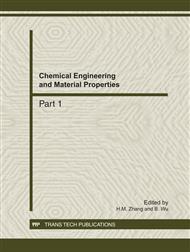p.1173
p.1179
p.1183
p.1189
p.1195
p.1200
p.1205
p.1210
p.1215
Research on Preparation and Electromagnetic Properties of Polyaniline Nanofibers through Interfacial Polymerization
Abstract:
Conducting polyaniline (PANI) nanofibers were synthesized by interfacial polymerization with ethanol/water, n-butyl alcohol/water and n-hexyl alcohol/water as reaction media, respectively. It was characterized by four-probe method, FTIR, UV-Vis, XRD, SEM techniques etc. The results showed that the n-butyl alcohol/water system provided a better reaction environment for the preparation of PANI nanofibers. The optimal conductivity value of PANI nanofibers was 3.55 S/cm; the diameter was between 60 and 100nm and the length was from 600nm to several microns. The electromagnetic shielding effectiveness of the PANI nanofibers was from 38dB to 79dB, which was measured by coaxial method from 10KHz to 4GHz. According to the results, the PANI nanofibers could be used as electromagnetic shielding materials.
Info:
Periodical:
Pages:
1195-1199
Citation:
Online since:
December 2011
Authors:
Price:
Сopyright:
© 2012 Trans Tech Publications Ltd. All Rights Reserved
Share:
Citation:


